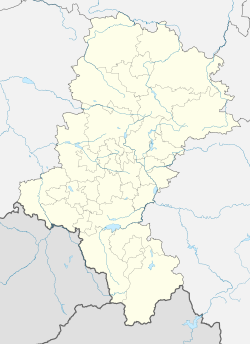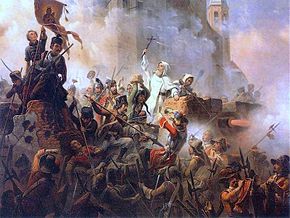You can help expand this article with text translated from the corresponding article in Polish. (March 2016) Click for important translation instructions.
|
 | |
  | |
| Monastery information | |
|---|---|
| Order | Pauline Order |
| Established | 1382 |
| Diocese | Częstochowa |
| Controlled churches | Basilica of the Assumption |
| People | |
| Founder(s) | Vladislaus II of Opole |
| Prior | Samuel Pacholski OSPPE |
| Site | |
| Location | Częstochowa, Poland |
| Coordinates | 50°48′45″N 19°05′50″E / 50.81250°N 19.09722°E / 50.81250; 19.09722 |
| Public access | yes |
| Historic Monument of Poland | |
| Designated | 1994-09-08 |
| Reference no. | M.P. z 1994 r. Nr 50, poz. 413 |
The Jasna Góra Monastery (Polish: Jasna Góra [ˈjas.na ˈɡu.ra] , Luminous or Light Mountain, Latin: Clarus Mons) in Częstochowa, Poland, is a shrine dedicated to the Virgin Mary and one of the country's places of pilgrimage. The image of the Black Madonna of Częstochowa, also known as Our Lady of Częstochowa, to which miraculous powers are attributed, is one of Jasna Góra's most precious treasures.
The site is one of Poland's official national Historic Monuments (Pomnik historii) and is tracked by the National Heritage Board of Poland.
History

by January Suchodolski

Jasna Góra Monastery was founded in 1382 by Pauline monks who came from Hungary at the invitation of Władysław, Duke of Opole. The monastery has been a pilgrimage destination for hundreds of years, and it contains an important icon of the Virgin Mary. The icon, depicting the Mother of God with the Christ Child, is known as the Black Madonna of Częstochowa or Our Lady of Częstochowa, which is widely venerated and credited with many miracles. Among these, it is credited with miraculously saving the Jasna Góra monastery during the Siege of Jasna Góra that took place at the time of The Deluge, a 17th-century Swedish invasion. The event stimulated the Polish resistance. The Poles could not immediately change the course of the war, but, after an alliance with the Crimean Khanate, they repulsed the Swedes. Shortly thereafter, in the cathedral of Lwów (Lviv), on April 1, 1656, Jan Kazimierz, the King of Poland, solemnly pronounced his vow to consecrate the country to the protection of the Mother of God and proclaimed Her the Patron and Queen of the lands in his kingdom.
In 1909, during the Congress Poland period, thieves broke into the monastery and stole millions in rubles worth of jewels, pearls, and other valuables. The icon itself was not damaged. Crowds of praying and weeping people gathered at the closed monastery when the theft was discovered. Pope Pius X himself offered to replace the crown that was stolen, and the coronation occurred in 1910. The coronation attracted Poles from both the Russian and Austrian partitions. Special trains brought people from Warsaw, and the crowds numbered up to 60,000. A monk named Damazy Macoch confessed to the crime in 1910.
Among the monastery's most important exhibits is the medal from the 1983 Nobel Peace Prize received by Lech Wałęsa, the former Polish president and trade-union organizer.
Walking pilgrimages
Every year since the Middle Ages, thousands of Poles go in pilgrim groups to visit Jasna Góra. In 2011, it was estimated that 3.2 million pilgrims from 80 countries around the world went to the shrine. Around 830,000 pilgrims took part in 228 pilgrimages organized in different places across Poland, 143, 983 of which reached the monastery on foot. The average distance for a pilgrim group to travel is about 350 kilometres (217 miles), made in 11 days.
Monastic etiquette
There are typically numerous pilgrims and tourists at Jasna Góra Monastery, and the volume of excited voices can be high. However, upon entering the Monastery, it is expected etiquette for visitors to be silent or as quiet as possible out of respect. Often, there is a long line of people who wait to approach the shrine of the Black Madonna of Częstochowa. Upon arriving at the place of the shrine at which one would pass in front of the icon of Our Lady, it is expected and a sign of respect for pilgrims to drop to their knees, and traverse the anterior of the shrine on their knees.
Gallery
-
Jasna Góra Monastery
-
 The main nave of the basilica
The main nave of the basilica
-
Pilgrims arriving for the Feast of the Assumption
-
Pope Benedict XVI on Jasna Góra in 2006
-
 View of the tower
View of the tower
-
Interior of the monastery
-
Knights' Chamber
-
 Main Altar
Main Altar
-
 Organs inside the main building
Organs inside the main building
-
 Lubomirski Gate
Lubomirski Gate
-
Statues in the monastery
-
Pilgrims visiting the monastery in 2012
-
Monastery building
-
View of the park
See also
References
Bibliography
- Czesław Ryszka. W Maryjnej Twierdzy (in Polish). Urząd Miasta Częstochowy. Archived from the original on January 4, 2014. Retrieved July 24, 2013.
{{cite book}}:|work=ignored (help)CS1 maint: bot: original URL status unknown (link) - Aleksander Radecki (1990). Piesza Pielgrzymka Wrocławska 1981–1989. Mokrzeszyn.
{{cite book}}: CS1 maint: location missing publisher (link) - Jan Pach; Włodzimierz Robak; Jerzy Tomziński (2001). Jasna Góra. Sanktuarium Matki Bożej. Przewodnik (in Polish). Częstochowa: Wydawnictwo Zakonu Paulinów.
- Mirosław Zwoliński (1997). Przewodnik po Częstochowie (in Polish). Częstochowa. pp. 87–112.
{{cite book}}: CS1 maint: location missing publisher (link)
Notes
- Zarządzenie Prezydenta Rzeczypospolitej Polskiej z dnia 8 września 1994 r. w sprawie uznania za pomnik historii., M.P., 1994, vol. 50, No. 413
- "Częstochowa official website". Urząd Miasta Częstochowy, Śląska 11/13, 42–217 Częstochowa. Archived from the original on February 8, 2009. Retrieved October 22, 2008.
- "Zarządzenie Prezydenta Rzeczypospolitej Polskiej z dnia 8 września 1994 r. w sprawie uznania za pomnik historii". SEJM.gov.pl. Retrieved March 17, 2016.
- "Jasna Góra". 1998–2008 Copyright by Klasztor OO. Paulinów Jasna Góra – Częstochowa. Retrieved October 22, 2008.
- Guth, Klaus (1995). "Pilgrimages in contemporary Europe: Signs of national and universal culture". History of European Ideas. 20 (4–6): 831–835. doi:10.1016/0191-6599(95)95818-2. ISSN 0191-6599.
- "DESPOIL IMAGE OF VIRGIN.; Robbers Take from Polish Convent Jeweled Raiment Worth Millions". The New York Times. ISSN 0362-4331. Retrieved September 7, 2024.
- Glover, J. (2005). Our Lady of Czestochowa Queen of the Kingdom of Poland. Catholic Insight, 13(9), 20-.
- "BRINGS 60,000 PILGRIMS.; Poles Assemble to Sea Dedication of Crown Presented by the Pope". The New York Times. ISSN 0362-4331. Retrieved September 7, 2024.
- "ARREST MONK FOR MURDER.; Confessed Killing Cousin After Despoiling Image of the Virgin". The New York Times. ISSN 0362-4331. Retrieved September 7, 2024.
- Kifner, John (December 13, 1983). "Walesa Takes Nobel Medal To Polish Shrine". The New York Times. Retrieved January 30, 2017.
- "The "Madonna of Czestochowa" And The Nearby Area". Retrieved April 4, 2019.
- "Telewizja Dami – Grupa Medialna". Telewizja.radom.pl. August 15, 2012. Archived from the original on January 4, 2014. Retrieved March 12, 2013.
External links
- Jasna Góra website(in English, Polish, Spanish, German, and Italian)
- Jasna Góra and the Shrine of Our Lady of Częstochowa